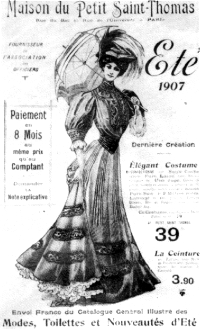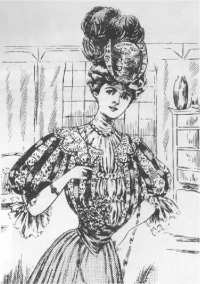Women's Fashion in early Johannesburg (1800's - 1900's) Page 2

Afrikaans-speaking women usually wore a hat when visiting town or attending a family function. This was in accordance with the strictures of St Paul that a head covering was necessary whenever a woman was about to pray or prophesy or who could find herself in a situation where she might need to pray or prophesy.
A favourite shape of has was the bonnet or kappie which not only concealed the wearer's hair but protected her face from the hot African sun. English-speaking women, as well as the more emanicpated Afrikaans girls, usually sported the postillion or Rembrandt hat which was ornamented with ostrich plumes at the brim and usually turned up at one side. Stuffed birds were often added to the millinery trimmings.
Hair was drawn back off the ears or dressed high in a bun. The front hair was often combed low on the forehead. Apart from the compulsory hat no well-bred woman ventured out of doors without her gloves and parasol.
As the decade which saw the founding of Johannesburg came to an end the bustle disappeared from European dress, but not so in South Africa, where it contined to be worn until the mid-nineties.
By 1894 the general design in costume had become less complicated. Skirts fitted snugly over the hips, flowing to the floor in a bell shape. While strolling along the dusty streets of the town the well-bred Republican Miss held up her skirt to the one side, the correct handling of which became an art characteristic of the period.
Skirts were cut in many gores and interlined with stiffening. The sleek hourglass silhouette eliminated the wearing of numerous petticoats; only one was necessary and that fitted tightly over the hips.
The leg-of-mutton sleeve stiffened with buckram grew to outsize proportions, reaching its most voluminous by the end of 1895, after which it slowly shrank in size like a deflated balloon. The soft, overhanging blouse was always finished with a belt. It was fashioned of sheer fabric and ornamented with lace or braid. The collar of the blouse was high and often chafed the wearer's neck and ear lobes.


Images. Left: The itinerant smous supplied the village dressmaker with materials so that she could make the latest models from the patterns that she regularly received. The drawing shows an outfit of the century's first decade. Both blouse and headdress contributed to completing the women's S shape. Right: Layers of lace which cascaded gently down the entire length of the wearer's blouse helped conceal the exaggeratedly unnatural shape of her body.
Black tailored suits with jacket, skirt, and white shirtwaist took a firm hold during the decade known as the 'roarin nineties'. Afrikaans women favoured black as much as their English counterparts, and so the nineties can be remembered as a decade when both language groups dressed alike. The Princess style which fitted like a glove, gored from neck to hem, dates from 1899, by which time the wide skirt as well as the balloon sleeve had disappeared.
During the three-year long war which impoverished the Transvaal, most of the population fled to the coast if English-speaking, or farther into the heart of the Transvaal if Afrikaans-speaking. Life came to a standstill in the mining town as its female inhabitants deserted the place.